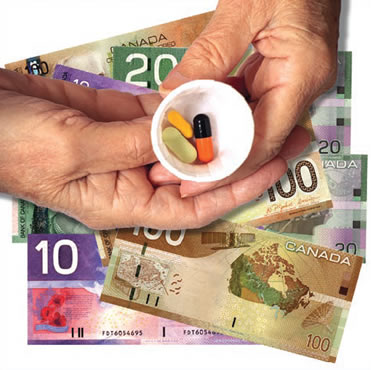Creating a national pharmacare program could slash more than $10.7-billion off Canada's $25-billion-a-year drug bill, according to a new study that dismisses out-of-hand the notion that a public drug plan is unaffordable.
“Canadians cannot afford not to have universal pharmacare,” said Marc-André Gagnon, an assistant professor in the School of Public Policy at Carleton University in Ottawa.
The report, being released Monday in Ottawa, argues that Canada's jumbled assortment of public and private plans and wildly varying drug policies across jurisdictions is inefficient, costly and inequitable.
But, above all, it says Canada pays too much for drugs – between 16 and 40 per cent more than other industrialized countries – in a bid to attract pharmaceutical investment.
In fact, the vast majority of the purported savings – $10.2-billion – would come from adopting a drug-purchasing policy based on market competition and the assumption prices would drop 37 per cent. That would likely provoke a backlash from the pharmaceutical industry and may be politically unpalatable, researchers concede. However, in a number of other scenarios presented in the study, Prof. Gagnon shows, even without purchasing drugs at that lower price, a national program would still deliver net savings of ranging from $2.6-billion to $4.5-billion.
The report suggested that doing rigorous drug reviews and price negotiations, as done in New Zealand, could generate annual savings of $9.3-billion. Savings from cheaper administration costs, eliminating federal tax subsidies to insurance plans and eliminating multiple private plans would produce more than $1.4-billion in savings, for a total of about $10.7-billion.
He said consumers would be better served by a national drug pricing and purchasing system and drug policies aimed at improving access and affordability rather than the current approach where the desire to attract investment in the pharmaceutical sector inflates prices.
The 120-page paper, prepared for the Canadian Centre for Policy Alternatives, argues that countries with national pharmacare programs, such as the U.K., France, Australia, New Zealand and Sweden, all have lower drug prices.
Prof. Gagnon said there is no question that drug spending has risen sharply – an average of 10.5 per cent a year since 1985. This demonstrates that it is virtually impossible to control costs with the current system. It has also created a “perception that pharmacare program would eventually place an untenable burden on public finances,” he said.
The reality though is that costs have increased twice as quickly in private drug plans as in public plans – in large part because they do not have bulk purchasing power. Administrative costs are also higher in private plans compared to public plans – eight per cent versus two per cent.
The report suggested that rigorous drug reviews and price negotiations could generate annual savings of $9.3-billion. Savings from cheaper administration costs, eliminating federal tax subsidies to insurance plans and eliminating multiple private plans would produce more than $1.4-billion in savings, for a total of about $10.7-billion.
Prof. Gagnon said one of the most troubling aspects of Canada's current regime is that it is inequitable. Public drug plans cover those over the age of 65 and recipients of social assistance, while others tend to depend on private plans offered through their employers.
However, there are big gaps. As many as eight million Canadians do not have adequate coverage for prescription drugs, according to the paper. That lack of access can often translate into higher medical costs.
Prof. Gagnon concedes that a universal pharmacare program would increase prescription drug use – an estimated 10 per cent overall. But it is argued that those additional costs would be more than offset by cost savings that come from adopting other policies.
A major impediment to creating a national pharmacare program is that health is a provincial responsibility. But the study argues that pharmacare does not need to be a federal program but a national one, where provinces and territories agree to a common set of standards to “ensure coherence.”
The way to create a cost-effective plan, Prof. Gagnon said, is to adopt the best practices from existing plans.
B.C., in particular, is held-up as a model. The province has the lowest per capita drug costs, its residents use the least medication per capita and they pay the lowest unit prices for their drugs. That is because B.C. has aggressively used policy like therapeutic substitution – where the drug plan pays for the cheapest equivalent drug, usually a generic.
Currently, prescription drug prices are established by the Patented Medicines Prices Review Board, based on the median price in seven other countries. In the paper, Prof. Gagnon argues that while that process ensures consistency, it also keeps drug prices artificially high because its formula includes the four countries with the most expensive prices in the world.

